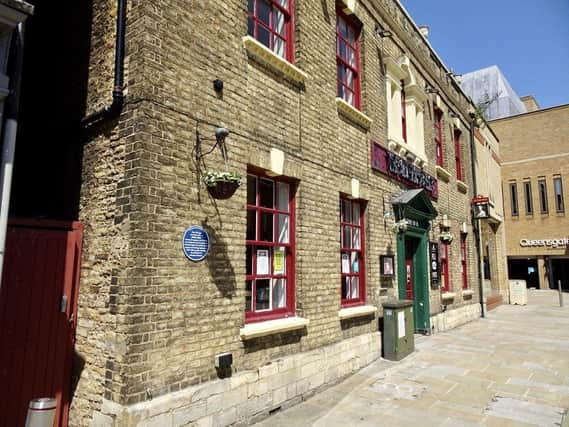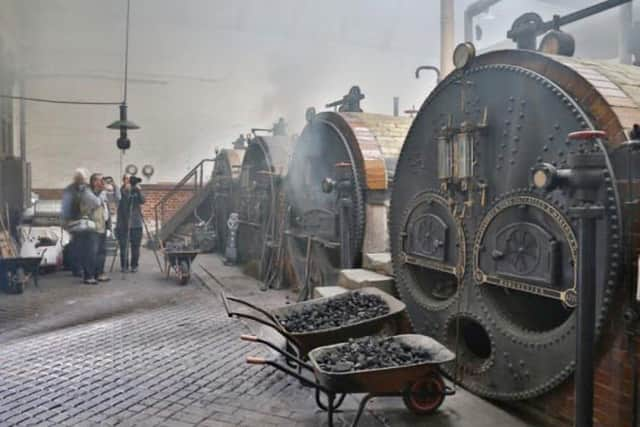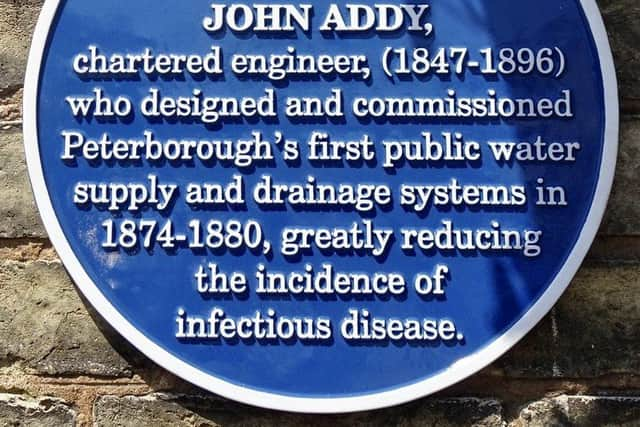They cheered him in the streets - the man who brought clean water to Peterborough


This plaque is located on the front wall of The Queen’s Arms, Queen Street.
In Victorian times, the risk of serious infection was ever present. In Peterborough, in August 1874 alone, thirty cases of typhoid were reported, some fatal.
Advertisement
Hide AdAdvertisement
Hide AdIt was generally accepted that outbreaks of infectious disease were mainly caused by impure water and poor sanitation, but water from the Peterborough Town Pump was known to be heavily contaminated.


There had been much talk that “something must be done”, but with minimal actual progress.
All that was now to change. The man mainly responsible for bringing change was John Addy, a local lad made good.
In 1874, Peterborough was a growing railway hub, with its own elected local authority, the Peterborough Corporation. Its members were keen to show they could make progress where others had failed.
Advertisement
Hide AdAdvertisement
Hide AdThey chose Addy, a chartered engineer, aged only 27, to assume full responsibility for both the new water supply and a new sewerage system for the whole of the city.


John Addy was born at West Deeping in 1847 and attended Grantham Grammar School. After a brief period as a mechanical engineering apprentice, he turned to civil engineering. He became Resident Engineer for the Croydon Sewage Works scheme in 1871 and received the Miller Prize of the Institution of Civil Engineers in 1872.
Addy set up his own practice in 1874 based in Queen Street. His work for Peterborough included preparing designs and supervising works, but also appearing before public inquiries and Parliamentary Committees.
The Corporation hoped to find suitable water supply at Castor, a relatively cheap solution, but an initial bore there proved unsuccessful. Addy turned instead to the village of Wilsthorpe in Lincolnshire, where the geology was known to be favourable. This proved highly satisfactory with a flow of 800,000 gallons per day. The Wilsthorpe site remains in use today.
Advertisement
Hide AdAdvertisement
Hide AdAddy’s engine house (since demolished) contained steam powered pumps and a storage reservoir was constructed nearby. From there, water flowed through an 18inch diameter main over 13 miles to Peterborough including crossing the River Welland. Twenty-five miles of pipes were then laid within the city.
The water supply was completed in July 1879 at a cost of £87,568 (more than £10 million in today’s money). Addy was “loudly cheered” in the city during the ensuing celebrations.
The works for the drainage scheme began in 1877, but in 1879 the contractor became bankrupt. The Corporation asked Addy to organise the remaining works, which he did, with completion in 1880, costing a further £80,000.
Addy’s relationship with the Corporation was often strained. He ceased working for them in 1881 and left the area to take up farming. He died in 1896.
Advertisement
Hide AdAdvertisement
Hide AdAddy deserves to be better known, not just as a highly competent engineer, but also because he overcame many difficulties for the lasting benefit of the city. Because of his work, Peterborians were at last able to enjoy an assured supply of clean water and the efficient disposal of sewage, which we take for granted today.
This plaque is one of a series of 15 blue plaques recently installed in central Peterborough by Peterborough Civic Society. Further details about all the plaques will soon be found in the accompanying booklet which will be available at the Town Hall or via the Society’s own website once the Covid-19 lockdown restrictions are relaxed.
In the meantime, a download of the booklet is available on the Society’s website.
We wish to acknowledge the support provided for this plaque by Charles Wells brewery and from the National Lottery Heritage Fund and Peterborough City Council for the others.
Thanks are also due to local author Betty Chambers MBE, whose book ‘Victorian Peterborough and Mr Mayor’ was the source of much of the information quoted above.